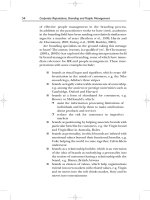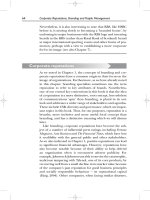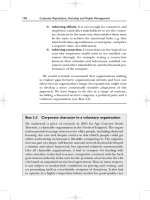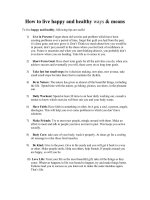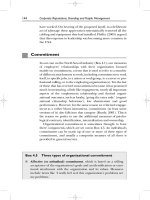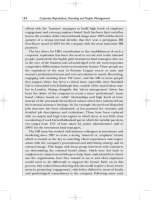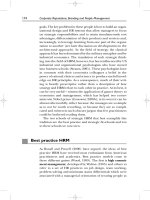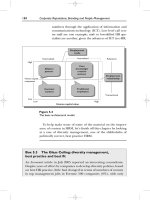Learn and Manage cash rules_4 doc
Bạn đang xem bản rút gọn của tài liệu. Xem và tải ngay bản đầy đủ của tài liệu tại đây (147.87 KB, 22 trang )
ROSS MARGIN IS SALES MINUS THE DIRECT COST OF
the product or service, which on the income
statement is usually called cost of goods sold or
cost of revenue. Sometimes, in a straight service
business, though you might not use the same ter-
minology you might list service-cost elements along with all the
other operating-cost categories. Whenever possible, though, it
is usually best to break out the specific cost of providing services
separately from selling, general and administrative (SG&A)
expenses. This is particularly important when there are mean-
ingful distinctions in selling price and cost structure from one
product, service type or cost element to another.
Gross margin in manufacturing, wholesaling and retailing
is a particularly critical point of focus. First of all, it is what’s
available to cover all operating overhead, financing costs and
income taxes, as well as any distribution to owners. It had bet-
ter be sufficient. One way of helping to ensure sufficiency is to
design your motivation and measurement systems so that they
support the goal of maximizing gross-margin dollars.
There is an old adage that says you get what you measure.
If you measure sales volume as the primary determinant of
marketing success and as the basis on which to set marketing-
related budgets, guess what? Sales will probably go up. But
actually, increased sales volume isn’t what you want. A higher
G
Gross Margin: First
of the Fundamentals
103
|
CHAPTER SIX CASH RULES
CHAPTER SIX CASH RULES
gross margin is what you really want. If everyone involved in
your sales and marketing would internalize that lesson and
focus on its implications for both profit and cash flow, chances
are you would get what you really want instead of just raw sales
volume. Your managers should consider
applying commission rates or ad-budget
percentages against dollars of targeted
gross margin instead of against sales vol-
ume. Susan McCloskey understands
this; she markets nearly $5 million in
mostly refurbished furniture each year
through the company she heads, Office
Plan Inc., in St. Paul, Minn. And the
sales force commission structure is
geared not to sales volume at all, but
directly to dollars of gross margin.
The same principle of measuring and rewarding what you
are trying to achieve holds true when you look at product mix.
Different products have different levels of margin. That reality
needs to be reflected in product-management budgets as well
as in the commission and advertising plans. Maybe there are
also implications for product-mix optimization in package-pric-
ing deals, or alternative delivery methods, or a variety of other
options. And at some point, you may have to consider simply
walking away from some lower-margin products or customers,
or at least put a priority on starting to find replacements for the
volume they represent.
The Two Sides of Margins
W
ith gross margin, raising price is one side of the equa-
tion; reducing cost is the other. Improvements on
either side of the equation increase gross margin.
Different order quantities and discounts can be analyzed and
negotiated to bring materials cost down. Long-term exclusive
contracts with fewer and more reliable suppliers may save not
only money but space as well. This works well when the supplier
will warehouse parts or materials and ship to you in smaller quan-
104
|
Different products
have different levels
of margin. That reality
needs to be reflected in
product-management
budgets as well as
the commission and
advertising plans.
105
|
tities as needed. Decide what you want to achieve and put it out
for proposal or bid. If you have a manufacturing operation, for
example, consider the elements of your product in terms of a
possible redesign. That may permit reductions in the number of
manufacturing steps or the number of
parts; also consider subcontracting out
low-skill elements to others with lower
cost structures.
All of these approaches can add to
margin and can be accomplished either
as part of an overall redesign project or
incrementally. Little by little, sharp
owners, partners, managers and super-
visors paying close attention to the
business elements nearest their daily
tasks can make a significant difference
in these areas. And cumulatively
through them, increase the company’s value. That kind of
enhancement takes not only an understanding of the impact of
the seven cash drivers, but also considerable discipline and
time. Following through with the necessary communication
and action takes plenty of effort.
On the price side of gross margin, you have presumably
already set pricing strategy and policies that represent some
kind of equilibrium point relative to your markets. As you con-
sider possible price changes, try centering the analysis on iden-
tifying a new equilibrium where opportunities for the spread
between total costs and total revenues are appreciably greater
than at present. Later in the chapter we’ll discuss pricing issues
relative to distribution-channel strategy. First, we’ll deal with
setting a new price within an existing channel. There are three
basic ways to accomplish this:
■ identifying and moving toward the product or service value already per-
ceived by the customer;
■ improving communication of your value message; and
■ creating incremental value in both real and perceptual terms.
Though any of these tactics may be the point of origin for
repricing, usually you need to give consideration to all three.
Gross Margin: First of the Fundamentals
As you consider possible
price changes, try
centering the analysis
on identifying a new
equilibrium where
opportunities for the
spread between total
costs and total revenues
are appreciably greater
than at present.
CHAPTER SIX CASH RULES
106
|
As with any decision, the incremental costs and revenues need
to be accurately estimated in each case. A bad pricing decision
is often harder to reverse or remedy than other missteps, so
accurate estimates become even more
important.
The first tactic for repricing focuses on
the appropriateness of current pricing—
that is, the market’s perception of the value
of your goods or services. It may be that
some reasonable level of price increase
would be generally acceptable in your mar-
ket without any particular need for ele-
ments of the second or third tactics.
The second tactic, improving commu-
nication of your own value message, may be very expensive, and
nearly impossible in the extreme case of product that is nearly
identical to its competitors, where there is little rationale for ven-
dor loyalty. On the other hand, a highly differentiated product
that is important to buyers would seem to have significant
upside pricing potential—probably in proportion to how clear-
ly customers understand and value the points of product differ-
entiation you are trying to convey.
Finally, the third tactic, value creation, generally incorpo-
rates elements of the first two in addition to redesign of the
product, service, maintenance, follow-up and ancillary aspects
of the business. Some of these can be enormously expensive
and others somewhat trivial.
Pricing is important enough that the results, or answers,
surrounding all three tasks need to be periodically updated
and reviewed in light of competitive, technological and macro-
economic events as well as customer perceptions.
Gross Margin & Contribution Margin
A
s important as gross margins are, they can conceal a lot
of important information if not dealt with on a product-
by-product or customer-by-customer basis. Aggregates
often hide useful distinctions. On average, the Jones Dynamite
The first tactic for
repricing focuses on
the appropriateness
of current pricing—
that is, the market’s
perception of the
value of your goods
or services.
107
|
Gross Margin: First of the Fundamentals
Co. has a gross margin of 65%, but the gross margins on its indi-
vidual products and services range from 18% to 77%. Not only
do gross margins vary widely, but so do contribution margins.
Recall that contribution analysis separates all costs into either
fixed or variable. It then calculates a contribution margin, that
is, how much of every sales dollar is available to help cover—
that is, contribute to—fixed costs and profit. Knowing what gross
margins and contribution margins are on both a product and
customer basis can improve overall margins by positioning you
to take specific action where needed. That knowledge also helps
you avoid coming up with overly broad solutions that affect
products or customers that need no particular action or adjust-
ment. Consider this example for two of Jones’s 16 product lines:
PRODUCT LINE A PRODUCT LINE B
Revenue $78,000 $56,000
Purchase or service cost $33,250 $16,800
Gross margin $44,750 $39,200
Gross margin % 56.8% 70.0%
Variable selling cost $11,200 $13,850
Variable administrative cost $1,550 $1,750
Contribution margin $32,000 $23,600
Contribution margin % 41.0% 42.1%
Based on gross-margin percentage, product line B is the
clear winner, but when contribution margin is calculated the two
lines are virtually identical. If you were looking at gross margins
alone, some bad decisions could easily be made.
If there are good business reasons, and there usually are,
there is nothing wrong with having different levels of gross mar-
gins for different products. What is wrong is to assume that
higher gross margins are inherently more profitable without
first considering other elements of cost. Addressing the full cost
issue is what contribution margin as illustrated in this Jones
Dynamite example is all about. Suppose, for example, that
based on gross-margin percentages of 70% vs. 56% for products
A and B above, Jones decided to make some significant price
concessions on product B for customers who buy B over A in a
CHAPTER SIX CASH RULES
ratio of 2 to 1 or more. Without the above contribution-margin
analysis, this decision could wipe out the majority of true cus-
tomer profit. This is quite different from the intent, which was to
gain some competitive insulation from cut-rate offers that a new
supplier is starting to offer to some of Jones’s best customers.
Jones will indeed get the insulation but at a cost far higher than
anticipated.
Refining Gross-Margin Calculations
J
ones, in the preceding example, is a wholesaler and retail-
er. The issues get even more complicated in a manufac-
turing environment because there are so many more
aspects and categories of costs that mount up as a product
moves through a complex manufacturing process. Further
rationalizing of those cost analyses and margin calculations
can be nearly impossible without the use of a system that is
designed to help you keep accurate track of the true costs of
each step for each job or product. Fortunately, such activity-
based costing (ABC) systems are readily available to track and
assign costs accurately.
In plants that manufacture only a few similar products,
having a single basis rate on which to allocate overhead costs
makes sense. Most commonly that basis is labor hours because
traditionally that has been the biggest cost element. The
greater the number of different products and the greater your
manufacturing complexity, the more likely it is that an ABC sys-
tem will be a worthwhile investment. The conversion to an
ABC system is a big project but one that will help reveal many
unsound pricing and other decisions that are currently being
masked by simplistic assumptions about assignment of factory
overhead costs.
In a more complex environment, with more manufacturing
steps, more departments and more products, overhead cost
allocation should probably be broken out by each activity
involved. ABC systems are really necessary in such cases, where
labor rates may vary widely from one department to the next,
108
|
109
|
and the relative mix of inputs may also vary by department. So
in a hypothetical plant, department A may be highly labor-
intensive with relatively highly paid specialists. Department B
may also be labor intensive but
employ much lower-cost general fac-
tory labor. Department C, by contrast,
may be highly automated with mini-
mal labor. Clearly, labor hours alone
are the wrong way to allocate over-
head costs in this plant.
In the most complex manufac-
turing situations, with many different
products, activity-based costing is
necessary to develop detailed cost-
estimation processes for each activity
in each department of the plant. It is
important to get this kind of infor-
mation right because if you are using gross margins as a cash
driver, you must have confidence that the figures you use in
making decisions are reasonable approximations of economic
reality. If they are not, the errors will undoubtedly produce sig-
nificant negative cash-flow effects.
While activity-based costing is of primary importance in
accurately determining gross margins in a manufacturing envi-
ronment, management of purchasing and inventory is usually
the key in merchandising businesses, whether retail or whole-
sale. Timing, a sense of the market, the use of hedging, and
knowing when to take markdowns are core issues for main-
taining gross margins.
A key to success here revolves around the availability of the
right information at the right time in the right form. Pay atten-
tion to the design and use of the reports that your accounting,
finance and information-technology departments issue. Which
ones really get used and by whom? On what do the reports and
their readers focus and why? What do the relevant decision
makers most want to know, and when? How can you get better
information, sooner, in the most usable form, to the right peo-
ple? Even partial reasonable answers to such questions will put
your company on the road to higher gross margin. At the most
Gross Margin: First of the Fundamentals
If you are using gross
margins as a cash driver,
you must have confidence
that the figures you use
in making decisions are
reasonable approximations
of economic reality.
If they are not, the errors
will undoubtedly produce
significant negative
cash-flow effects.
basic level, anyone can contribute in this informational way.
Begin simply by taking the time to study and more fully under-
stand the content and implications of everyday reports as they
exist. Pass your insights about this information along in writing
to those who can best use it, and be willing to let them take, or
at least share, the credit.
As you analyze your business from a gross-margin perspec-
tive, consider both the marketing and the production (or pur-
chasing) sides of the firm. If you see a
trend of decline in gross margins, it
probably means that your company is a
price taker—that it does not have suffi-
cient power in the marketplace to be
able to raise prices enough to cover all
cost increases. Alternatively, a downward
trend in gross margin when the same
margin-erosion problem is not being
experienced by the overall industry usu-
ally suggests production inefficiencies or
poor buying patterns.
If you work in production, produc-
tion planning, purchasing or product
development, be alert for those things
that will add value for your customers.
Improvements in perceived value can
help to hold the line on or even increase acceptable pricing lev-
els. This would include anything that improves product quali-
ty or utility to customers. Anything you can economically do to
add value or heighten the perception of value offers possibili-
ties for protecting or enhancing gross margin. The same prin-
ciple holds true for anything you do in terms of direct and indi-
rect customer experiences with your company. These would
range from something as fundamental as product design and
basic distribution-channel selection to such ancillary factors as
packing and shipping. Additional value-creation opportunities
abound in most companies. The trick is to motivate and
empower people to act on them at their individual levels of
influence. Equipping people with cash-driver language is an
important early step in that direction.
CHAPTER SIX CASH RULES
110
|
Additional value-
creation opportunities
abound in most
companies. The trick
is to motivate and
empower people to
act on them at their
individual levels of
influence. Equipping
people with cash-
driver language is an
important early step
in that direction.
111
|
Distribution Channels & Gross Margin
A
major issue in gross-margin analysis is distribution-chan-
nel strategy. It is particularly critical for Sally Fegley and
her husband, Tom, who built Tom and Sally’s
Handmade Chocolates Inc., in Brattleboro, Vt., from under
$100,000 to over a million dollars in just nine years, and ship to
all 50 states and six European countries. But because their 100-
year- old handcraft techniques for making chocolate are very
labor-intensive, opportunities are fairly limited for economies of
scale on the production side as a way of growing their business.
On the selling side, Tom and Sally are evaluating a shift
toward direct retailing as a significant growth source.
Properly managed, this strategy holds the potential for enor-
mous improvement in gross margins. It is also, however, a
major strategic shift that will materially change the character
of the business. The change will appreciably affect both their
occupancy and labor costs, which will undoubtedly rise sig-
nificantly with a move into retail. But perhaps the biggest cost
will be the management time and energy involved in such a
dramatic shift in distribution channels. Consider the business
issues involved.
Price, gross margin and distribution-channel strategy are a
cluster of issues that need to be evaluated interdependently.
The essential questions revolve around identifying the sequence
of functions that need to be performed to get the end customer
satisfied, and determining for each step in the sequence who
can offer the best price and performance. The questions are
deceptively simple and don’t lend themselves to generalizations.
One broad trend, however, is toward shorter channels with
a particular emphasis on direct selling. The demand side of
this trend is driven by customers who want to benefit from the
lower prices that are often made possible by reducing the num-
ber of steps and players in the distribution channel. The sup-
ply side was driven initially by larger firms in the early ’80s;
they began hard-wiring themselves into a network of buyers
and sellers operating over dedicated lines and using electronic
data interchange (EDI) protocols.
More recently, the Internet has further accelerated the
trends toward shorter channels and direct selling to near
Gross Margin: First of the Fundamentals
CHAPTER SIX CASH RULES
112
|
warp speed, as EDI has now developed Internet capabilities.
Internet sales in 1998 totaled about $25 billion, and two-
thirds of that was business to business. On the other hand,
there is a huge target pool of business-to-business goods cur-
rently moving through wholesalers at
the rate of $2.5 trillion annually, with
gross margins averaging somewhere in
the 30% range. Think about that: Thirty
percent of $2.5 trillion presents a $750
billion target for gross-margin reclama-
tion from wholesalers. Many producers
and dot-coms will be lining up to take
aim at a target of that magnitude. And
Internet sales growth is catching up to the traditional bricks-
and-mortar retail segment of the economy. The direct-selling
trend is not limited to the internet; consumer catalog and
telephone sales continue to grow. Direct selling is also
expanding to business-to-business sales in industries that
previously followed less-direct channels.
Dell Computer has prospered largely by taking a leading
role in radical channel and supply-chain changes. Jim
Schneider, the senior financial vice-president at Dell, empha-
sizes that channel-analysis questions must focus on the cost-
effectiveness with which an enterprise can assume the middle-
man’s value added. Among the first considerations for analyzing
the business case will be the effects on: sales-growth rate, the
fundamentals, swing factors and capital expenditures. Sound
familiar? Channel realignment can easily have an impact on a
business at the level of every one of the seven cash drivers.
Probably the major fear and trade-off area in distribution-
channel analysis has to be the potential cost of channel clash, as
when some middleman starts seeing you as a competitor. For
example, an art-supply wholesaler I know began a direct-mail
and Internet promotion to end users. This badly damaged
relations with many of her longtime retail-store accounts. Bear
in mind that if you start selling directly to end-use customers,
your former retail accounts may decide to become your com-
petitors by aligning with other producers to replace the volume
they lost from you. The biggest risk in that situation may be
The Internet has
further accelerated
the trends toward
shorter channels and
direct selling to
near warp speed.
113
|
that those retailers have better relationships with end-use cus-
tomers than you do and a more in-depth understanding of
their needs.
Gross Margin &
Totally Perishable ‘Inventory’
I
n service businesses, while there is no inventory in the tra-
ditional sense, there is often some resource that you can-
not easily just stop and start buying as the marketplace
changes. Examples would include airline seats, motel rooms
and a staff of professional consultants for hire. In these cases,
resource management and supporting information systems
become even more critical for maintaining margins because
you essentially have to pay for the resource that you don’t use.
You can never again use last night’s unoccupied motel room.
Unbilled staff hours never come around again. In other
words, the service is totally perishable.
Judy Nagengast at Continental Design understands this
perishability principle. She and her husband run an organiza-
tion of more than 320 employees, most of whom work on fair-
ly long-term project assignments in the automotive design and
engineering field. The combination of competition and the
power of large customers to set prices means that margin
improvements can’t come on the price side. Maintaining mar-
gins in the contract-staffing business depends on keeping pro-
fessional employees as close to fully billed as possible. Judy
keeps this on track with the right balance and teamwork
between Continental’s recruiting staff and its sales staff. They
work hard to keep their information channels clear, accurate
and up-to-date. Good sales forecasting integrates almost seam-
lessly with targeted recruiting. The goal, of course, is never to
have to tell a client you don’t have the right specialist when
needed, but to fulfill client needs without having any more
unbilled hours than absolutely required for basics such as
training and some minimal administrative demands on the
professional’s time.
Gross Margin: First of the Fundamentals
CHAPTER SIX CASH RULES
In most respects, this focus on full utilization of fixed or
semi-fixed resources is as much an operating-expense issue as
it is a gross-margin issue. Let’s turn now explicitly to operating
expense—that is, selling, general and administrative (SG&A)
costs—as a cash driver unto itself.
114
|
OU HAVE BEATEN THE BUSHES TO RAISE THE SALES-
growth rate. You have managed to cut the costs
of meeting your customer’s needs to the lowest
level consistent with quality and competitive
pressures. You have revised your distribution-
channel strategy to broaden your market without sacrificing
gross margin. Now you need to focus on operating expense.
Selling, general and administrative expense (SG&A) is usu-
ally the next-biggest cash driver after sales growth and gross
margins. In a service business especially, this is where most of
your costs are unless you explicitly calculate and report a direct
cost-of-sales component. In a manufacturing or merchandising
business, more of your costs are typically in cost of goods sold,
but SG&A is still very significant and includes all the corporate
overhead items: the people and functions, the spaces, and
resources not directly attributable to the actual product. All
normal operating expenses, other than those associated with a
physical product (or service offering), are generally found
here—salaries, wages, commissions, bonuses, benefit expenses,
power, heat, light, rent, leases, operational taxes, travel, enter-
tainment, insurance and supplies.
SG&A excludes expenses not associated with the operating
elements of the business, such as investment, financing and
taxes. Although these categories are important and sometimes
Y
SG&A: The Other
Fundamental
115
|
CHAPTER SEVEN CASH RULES
CHAPTER SEVEN CASH RULES
significant in size, they are not items you deal with day to day
to get your product or service out to the customer.
Cost Ups & Downs
T
he SG&A category is so inclusive that it is somewhat
difficult to generalize about it as a category. But one
generalization that can be made is that it is always eas-
ier to let expenses go up than it is to bring them back down.
This is true whether SG&A is considered in dollars or per-
centages. The better the organization is doing, the easier it is
for costs to creep up. The worse it is doing, the more likely it
becomes that when costs are finally cut, the cuts will be made
quickly and will not be particularly well thought out. If you’re
bleeding profusely, the efficiency of the bandage isn’t closely
scrutinized.
The easiest cuts are usually the ones that have the least-
immediate impact on the success of the firm. Unfortunately,
they are often the cuts that will do the most long-term damage.
Consider training, for example, or advertising. There is usual-
ly little immediate negative impact on the business when you
cut such costs. But if they were good training programs and
sensible advertising campaigns, you will reap the bitter fruit of
such cuts months or years down the line. Because most busi-
nesses normally go through up and down cycles to some
degree, it is almost inevitable that you will add fat to the com-
pany in the good times and cut at least some muscle in the bad
times.
How have you responded to this yo-yo phenomenon in
your business? Is there any way to prepare for it or to offset
some of its effects? Maybe you could start with being sure you
have a clear awareness of how your sphere of influence adds
most directly to the organization’s success. What are the most
important things you do, the next most important, and so forth?
Identify the resources you need most critically to effectively and
efficiently make your contribution. Preparing in this way will
help you develop a much clearer distinction between what is fat
and what is muscle. With that distinction more clearly in mind,
116
|
117
|
you can focus on turning fat to muscle during the good times.
More muscle to begin with reduces both the likelihood and
severity of the eventual bad times. Don’t let costs creep up in
your area unless they are adding materially to quality, capacity,
insight or responsiveness. If you keep the organization aware
and informed of where the muscle is, then you and your mis-
sion-critical resources will have the best win-win chance of sur-
viving the inevitable cuts when tough times arrive.
SG&A & Capacity
T
here is an important dimension to SG&A that has to
do with capacity. Consider this issue by reflecting on
the following questions from the viewpoint of your
responsibilities:
What is the relationship generally between resources and revenue growth
in your situation?
What resources would have to be added in your area to accommo-
date a 10% increase in sales? How about a 25% increase?
What resources would such a sales increase affect most severely? You
need to know what the biggest constraints are. Maybe it is
space, or staff, or computer capacity. Perhaps insufficient park-
ing or the unavailability of some specialized back-ordered
resource would leave you short.
What could you least painfully give up if sales volume dropped and you
absolutely had to cut costs by 5%? What about a 15% cost
reduction?
As you make the mental trade-offs between these two directions, growth
and shrinkage,
what is your sense of their relative likelihood and
probable causes?
What step functions are at play—that is, what capacity-enhancing
resources can be bought only in fairly large chunks?
SG&A: The Other Fundamental
CHAPTER SEVEN CASH RULES
118
|
As an example of how that last question might apply to your
business, you might have to lease the whole upstairs floor in the
building you’re in to get more space for just a couple of new hires.
Planning ahead for such eventualities almost always creates more
options than waiting until the last minute. If, for example, your
offices were 85% occupied coming out of the last recession, maybe
that was the time to have committed to leasing the whole next
floor and subletting to smaller individual users on staggered,
short-term leases while you readied your business for the next
growth period.
Economies of scale are often an issue with SG&A. It is fre-
quently possible to pay only a small amount more for a lot of addi-
tional capacity. Resources as diverse as delivery trucks, advertising
space, telephone and computer systems fall into this category. Do
your homework. Get a sense of how close to capacity your various
resources are. Analyze the upgrade options and the price/perfor-
mance trade-offs for additional capacity. Then either make the con-
sidered decision or pass along the information to the responsible
party. Always consider the economy version on elements of both
equipment and services. The economy route is not always the best
choice, but it helps define the range. For example, unless your
computer needs demand state-of-the-art equipment, a system just
a year or two old may be sufficient for your needs and cost a frac-
tion of a new model. Various professional services such as attorneys
and publicists have widely different rates and retainer levels. If
your needs in these areas are relatively simple and straightforward,
why pay top dollar for the high-rent professionals when a journey-
man practitioner will do as well?
Expense & Expenditure
T
hus far, we have been talking primarily about expense-
related decisions. The significant cash dimensions of these
are obvious. Sometimes, though, what is not nearly so
obvious is the distinction between expense and expenditure. In
your personal life, you usually experience expense and expendi-
ture simultaneously when you buy something. In business, how-
ever, there is almost always a time gap between when an expense
119
|
SG&A: The Other Fundamental
is incurred and when you actually lay out the cash—that is,
make the expenditure.
This difference is at the heart of the cash-versus-accrual dif-
ferential. Other things being equal, the more you can manage
that time gap in your favor, the better your cash flow will be.
When I say other things being equal, I want to stress the point
that extending the time gap for payment
is good so long as it doesn’t create other,
larger problems. Let’s use a simple
example. There might be major morale
problems if payroll were to be converted
from every two weeks to a monthly basis.
Sure, it would free up cash; the cash-flow
benefit would equal, on average, a bit
more than another full week of payroll.
But the impact on employee relations
would probably not be worth it.
Regarding the sales force, perhaps it
could reasonably be argued that the com-
mission portion of earnings shouldn’t be
paid until the customer invoice is collect-
ed. There might be an even stronger
case for such a plan if the sales force nor-
mally has a direct role in accounts receiv-
able. But even in this common instance, don’t make such deci-
sions hastily. Check industry practice. See if there is research or
information of any sort on the topic.
In considering delaying commission payments, you may
find that some of the connection between sales-force accom-
plishment and its associated reward is broken. As a result, field
sales people could actually wind up performing at a lower level
when commission payments are delayed until payment of the
associated customer invoice. If this sales underperformance
turns out to more than offset the cash-flow value of delay, it is
probably best not to stir up that particular hornet’s nest. On the
other hand, if the selling environment is more relational than
merely transactional in nature, it is probably reasonable to
operate with your sales force on the basis that no sale is com-
plete until the cash is in the till.
In your personal
life, you usually
experience expense
and expenditure
simultaneously when
you buy something.
In business, however,
there is almost always
a time gap between
when an expense is
incurred and when
you actually lay out
the cash—that is,
make the expenditure.
CHAPTER SEVEN CASH RULES
Many companies thread this particular needle by paying
sales commissions upon billing but with the understanding that
they can be charged back. Chargebacks are most commonly
used if the customer invoice remains unpaid for more than
some defined period, say 90 days.
After revenue, SG&A is the largest single number on the
income statement for service businesses that don’t break out
cost of sales (or services). For companies that do break out cost
of sales (manufacturers, retailers, wholesalers and some service
companies) SG&A is typically the second-biggest number, fol-
lowing sales. In the majority of all cases, it is the most control-
lable or discretionary cost category and therefore warrants
careful consideration by senior management with regard to
long-term business strategy. Well-managed SG&A is truly fun-
damental, not just incidental, in almost every business.
As we leave the business fundamentals of gross margins and
SG&A, we move on to the swing factors—accounts receivable,
inventory and accounts payable. Though less central to the
business than the fundamentals, swing factors can sink your
business, despite good fundamentals, if they are not carefully
controlled. Similarly, they can save your skin if they are man-
aged particularly well when the fundamentals may be tem-
porarily going against you.
120
|
T THIS POINT IN THE SEQUENCE OF THE CASH-
driver discussion, we have examined sales
growth, documented its cost through cost of
goods sold, and been left with some gross mar-
gin from which to pay SG&A expense. Not
much of anything can get paid for, however, until you get paid
by your customer. This is precisely why accounts receivable
(A/R) is the first and most significant of the class of cash drivers
known as swing factors.
By offering customers payment terms other than cash on
the barrelhead, you automatically make four assumptions: that
the customer has both 1) the willingness and 2) the ability to pay
you; and that neither that 3) ability nor 4) willingness will fail
between the time the order is shipped and the time payment is
due. But any of those assumptions may turn out to be inaccu-
rate. The better you manage your receivables—the money that
is owed for work completed or products delivered—the less
likely you are to be bitten by a bad assumption. If you do get
bitten from time to time, the cost can be minimized if you have
clear policies about how deeply you will allow any account to
become indebted, and what steps you will take once further
credit is cut off.
Accounts receivable is discussed and measured in days
receivable, and the calculation is based on in sales dollars. That
A
Swing Factor #1:
Accounts Receivable
121
|
CHAPTER EIGHT CASH RULES
CHAPTER EIGHT CASH RULES
is to say, divide the dollars of accounts receivable by the dollars
of annual sales, and multiply the result by 365 (days per year).
(For contractors, costs and profits in excess of billings should be
considered a receivable for this purpose. By the same logic, on
the liability side, billings in excess of costs—so called front-end
loading—could be treated as payables.) If, for example, A/R is
$1 million and annual sales is $8 million, then 1/8 x 365 pro-
duces an A/R cash-driver value of 45.6. This means that there
are that many days worth of sales tied up, or invested, in
accounts receivable. Put another way, it takes an average of 45.6
days to collect on the typical sale.
If A/R days move upward from one period to the next, you
generally know that some kind of management decision or
practice has changed with respect to accounts receivable. If you
look only at dollars of A/R from period to period, you learn
nothing about the management of receivables per se. That’s
because the effect of sales growth is factored in when you exam-
ine dollar totals. But by checking the relative measure—that is,
the cash-driver measure of A/R days—you avoid being dis-
tracted by the effect on receivables of changes due to sales level.
By looking only at the
relative measure, A/R days, you narrow
the focus to things essentially attributable to A/R management
issues. Let’s consider the nature of some of those issues.
Communicating With Customers
A
ccounts-receivable aging reports have been around
forever. The reports sort and divide accounts or invoic-
es into 30-, 60- and 90-day categories. Companies
used to run these reports no more than monthly. That meant
that only customers who were a month or more behind in pay-
ing were contacted, which was not terribly efficient. Now,
many companies call every new customer on the day after the
first invoice-due date, whether or not payment has been
received. If the payment has been received, the call is mainly
to say thanks. If it has not been received, the call, while
reminding the customer that payment is due, offers an oppor-
tunity to ask if everything was OK with the order. This
122
|
123
|
approach gently clues new customers into the company’s focus
on on-time collections at the beginning of the relationship.
This initial phone call is also a great time to confirm that the
invoice went to the right person at the right address. If it did-
n’t, the invoice can bounce around for quite
a while before winding up in the right
place, especially in a large company.
Today, with the availability of inexpen-
sive computers and off-the-shelf software,
you can generate a receivables aging-report
daily, as needed—or better yet, automatical-
ly when predetermined triggers are set off.
Human nature being what it is, invoices
that are confusing, incomplete, inadequate-
ly detailed, hard to read, not well tied to
appropriate documentation, hard to follow
up on, or otherwise deficient create a signif-
icant rise in the probability of delayed payment. Your invoice
needs to be as carefully designed and thought through as your
marketing pieces and signage. Indeed, it is part of that contin-
uum—in some ways the most important part. Full-disclosure
invoices should also clearly set forth payment-date expecta-
tions, late-charge policy and information regarding the process
for resolving disputes. Marketing’s job is to make it easy to buy
from you. Accounts receivable’s job is to make it easy for cus-
tomers to pay you.
Despite best practice in receivables management, some-
times the small firm dealing with large customers is at a disad-
vantage. As Sally and Tom Fegley, for instance, consider shift-
ing their homemade-chocolates business into selling through
their own retail outlets, they hope not only to improve gross
margins but also to solve some accounts-receivable problems.
The biggest such problem is that many very large specialty
retailers have taken advantage of them at two levels: payment
terms, and return or charge-back policies. More growth
through their own retail outlets would help minimize the
effects of these often hidden costs. At the other end of the size
spectrum, the Fegleys have had to deal with the risk associated
with shipping to small retail outlets. With many of these
Swing Factor #1: Accounts Receivable
Your invoice needs
to be as carefully
designed and
thought through
as your marketing
pieces and signage.
Indeed, it is part
of that continuum—
in some ways the
most important part.
CHAPTER EIGHT CASH RULES
124
|
accounts, Tom and Sally ship only on firm credit card orders. And
as a general rule they never ship first orders on credit except to
large, reputable companies. This can be a good first-pass way to
weed out many con artists.
A/R & the Marketing Connection
I
n managing accounts receivable, don’t let marketing and
accounting work at cross-purposes. Your A/R staff needs to be
sensitive to the probability that delinquent customers are val-
ued clients who are just temporarily behind. Similarly, your mar-
keting and sales people need to have some sense of urgency about
getting—and keeping—their customers current on payment
obligations. Potential conflict can be reduced with good interde-
partmental communications, which could include getting the
departments together to jointly solve problems. At Office Plan
Inc., the office furniture re-furbisher we looked at in an earlier
chapter, receivables management is helped greatly by requiring
50% down payments at the time of contract for most sales.
Another less tangible, yet very real, help is that the sales people
are also stockholders; their equity participation in the company.
Not too surprisingly, Office Plan has no bad debt!
Sometimes tailored payment terms for a certain customer, or
easier payment terms across the board can be an important part of
the marketing mix. You might want to utilize such terms to react to
competitive pressures, to introduce a new product, to respond to
the seasonal needs of a customer, or for a variety of sales and mar-
keting tactics. Before you change payment terms, make sure you
have the full support of your accounts receivable, accounting and
finance staff. Part of that support is helping to analyze the true costs
and cash-flow implications of the strategy. This helps ensure that
genuinely sound trade-offs can be made in the best interests of the
firm as a whole rather than reflecting the more parochial interests
of a particular department.
Important marketing issues that have potentially significant
impact on cash-flow arise whenever we consider distribution-chan-
nel strategy or development of export sales. Amgen Inc. is a case in
point. This pharmaceutical firm has the best record in its industry
